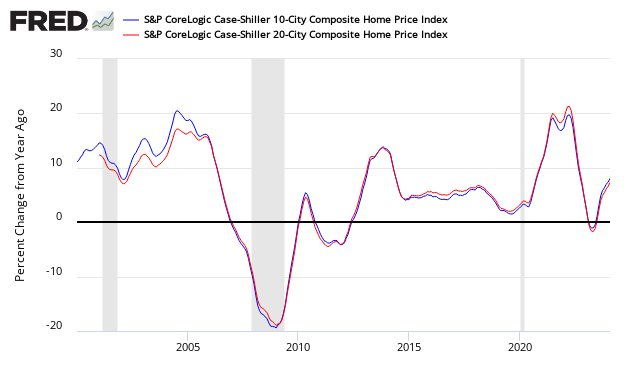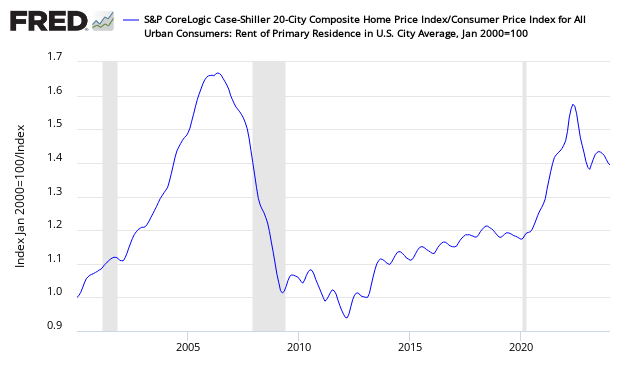Written by Steven Hansen
The non-seasonally adjusted Case-Shiller home price index (20 cities) for August 2014 (released today) rate of growth again declined but continues to show moderate year-over-year gain in housing prices.
- 20 city unadjusted home price rate of growth decelerated 1.2% month-over-month. [Econintersect uses the change in year-over-year growth from month-to-month to calculate the change in rate of growth]
- Case-Shiller no longer shows the highest year-over-year home price gains of any home price index – this honor now goes to CoreLogic.
- The market expected:
| Consensus Range | Consensus | Actual | |
| 20-city, SA – M/M | -0.3 % to 0.4 % | 0.1 % | -0.1% |
| 20-city, NSA – M/M | 0.4 % to 0.5 % | 0.4 % | 0.2% |
| 20-city, NSA – Yr/Yr | 5.3 % to 12.4 % | 5.8 % | 5.6% |
S&P/Case-Shiller Home Price Indices Year-over-Year Change

Comparing all the home price indices, it needs to be understood each of the indices uses a unique methodology in compiling their index – and no index is perfect. The National Association of Realtors normally shows exaggerated movements which likely is due to inclusion of more higher value homes.
Comparison of Home Price Indices – Case-Shiller 3 Month Average (blue line, left axis), CoreLogic (green line, left axis) and National Association of Realtors 3 Month Average (red line, right axis)
/images/z existing3.PNG
The way to understand the dynamics of home prices is to watch the direction of the rate of change. Here home price growth generally appears to be stabilizing (rate of growth not rising or falling).
Year-over-Year Price Change Home Price Indices – Case-Shiller 3 Month Average (blue bar), CoreLogic (yellow bar) and National Association of Realtors 3 Month Average (red bar)
/images/z existing5.PNG
There are some differences between the indices on the rate of “recovery” of home prices.
A synopsis of Authors of the Leading Indices:
Case Shiller’s David M. Blitzer, Chairman of the Index Committee at S&P Indices:
The deceleration in home prices continues. The Sun Belt region reported its worst annual returns since 2012, led by weakness in all three California cities — Los Angeles, San Francisco and San Diego. Despite the weaker year-over-year numbers, home prices are still showing an overall increase, as the National Index increased for its eighth consecutive month.
The large extent of slower increases is seen in the annual figures with all 20 cities; the two composites and the national index all revealing lower numbers than last month. The 10- and 20-City Composites gained 5.5% and 5.6% annually with prices nationally rising at a slower pace of 5.1%. Las Vegas continues to see a sharp deceleration in their annual home prices with a 10.1% annual return, down just below three percent from last month. Miami is now leading the cities with a 10.5% year-over-year return. San Francisco, which has shown double-digit annual gains since November 2012, posted an annual return of 9.0% in August.
Despite softer price data, other housing data perked up. September figures for housing starts, permits and sales of existing homes were all up. New home sales and builders’ confidence were weaker. Continued labor market gains, low interest rates and slower increases in home prices should support further improvements in housing.
CoreLogic believes home price growth is slowing (August Data). Per Mark Fleming, chief economist for CoreLogic and Anand Nallathambi, president and CEO of CoreLogic:
Home prices continue to rise, albeit more slowly, across most of the U.S. Major metropolitan areas such as Riverside and Los Angeles, California, and Houston continue to lead the way with strong price gains buoyed by tight supplies and a gradual rebound in economic activity.
The pace of year-over-year appreciation continues to slow down as real estate markets find more balance. Home price appreciation reached a peak of almost 12 percent year-over-year in October 2013 and has since subsided to the current pace of 6 percent. Continued moderation of home price appreciation is a welcomed sign of more balanced real estate markets and less pressure on affordability for potential home buyers in the near future.
The National Association of Realtors says investors continue purchasing at low levels (September 2014 data). Per Lawrence Yun , NAR chief economist and Steve Brown, NAR President:
Lawrence Yun, NAR chief economist, says the improved demand for buying seen since the spring has carried into the fall. “Low interest rates and price gains holding steady led to September’s healthy increase, even with investor activity remaining on par with last month’s marked decline,” he said. “Traditional buyers are entering a less competitive market with fewer investors searching for available homes, but may also face a slight decline in choices due to the fact that inventory generally falls heading into the winter.”
“Economic instability overseas is leading to volatility in the stock market and is causing investors to seek safer bets, which will likely keep interest rates in upcoming weeks hovering near or below where they are now,” said Yun. “This is welcoming news for consumers looking to buy, although they could temporarily become more cautious by less certain economic conditions.”
According to NAR President Steve Brown, fewer distressed sales is good news for appraisers, who have faced undue pressure since the downturn. “An appraisal is an important part of the home buying and selling process,” he said. “With foreclosures and short sales falling closer to average levels, appraisers will have fewer distressed sales in their list of comparables when determining home valuations.”
Black Knight Financial Services (formerly known as Lender Processing Services) August 2014 home price index up 0.1% for the Month; Up 4.9% Year-over-Year.

Econintersect publishes knowledgeable views of the housing market.
Caveats on the Use of Home Price Indices
The housing price decline seen since 2005 varies by zip code – and seems to have ended somewhere around the beginning of the 2Q2012. Every area of the country has differing characteristics. Since January 2006, the housing declines in Charlotte and Denver are well less than 10%, while Las Vegas home prices had declined almost 60%.
Each home price index uses a different methodology – and this creates slightly different answers. There is some evidence in various home price indices that home prices are beginning to stabilize – the evidence is also in this post. Please see the post Economic Headwinds from Real Estate Moderate.
The most broadly based index is the US Federal Housing Finance Agency’s House Price Index (HPI) – a quarterly broad measure of the movement of single-family house prices. This index is a weighted, repeat-sales index on the same properties in 363 metro centers, compared to the 20 cities Case-Shiller.
The US Federal Housing Finance Agency also has an index (HPIPONM226S) based on 6,000,000 same home sales – a much broader index than Case-Shiller. Also, there is a big difference between home prices and owner’s equity (OEHRENWBSHNO) which has been included on the graph below.
Comparing Various Home Price Indices to Owner’s Equity (blue line)


With rents increasing and home prices declining – the affordability factor favoring rental vs owning is reversing. Rising rents are shifting the balance.
Price to Rent Ratio – Indexed on January 2000 – Based on Case-Shiller 20 cities index ratio to CPI Rent Index

Related Articles
Old Analysis Blog | New Analysis Blog |
| Housing Sales and Prices | Housing Sales and Prices |










